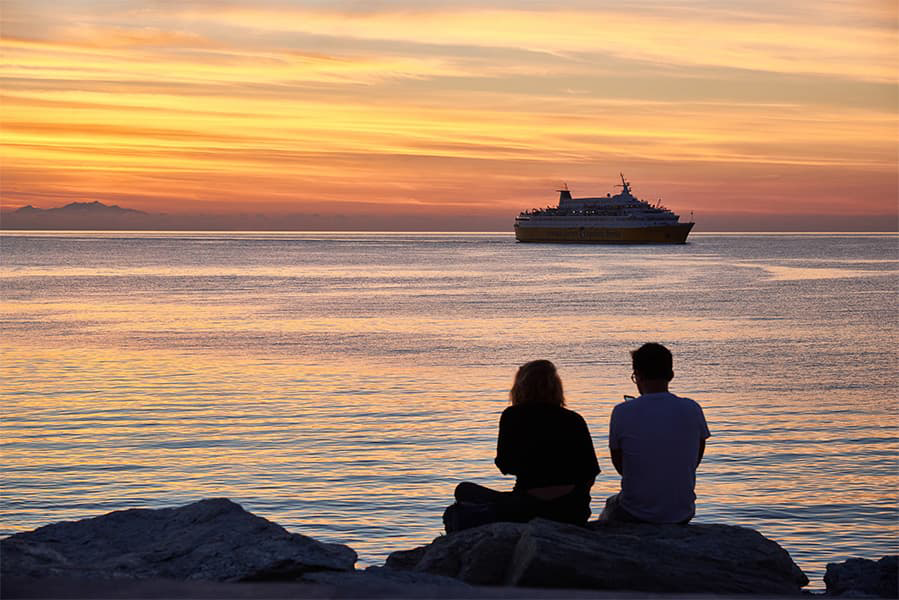Jersey – Carteret
Ferry to France
Jersey – Carteret
Ferry to France

Depending on the season their are about 3 weekly sailings between Jersey and Carteret.Manche Iles Express provides the ferry from Jersey to Carteret. Jersey Carteret ferries take around 1 hour 20 minutes. The ferry costs between $85.90 and $399.69, depending on ticket details. Prices exclude any service fees. Ferry timetables change seasonally, use our Deal Finder to get live pricing and availability for ferries from Jersey to Carteret.
The earliest Jersey Carteret ferry typically departs Jersey at about 06:50 and the last ferry usually leaves at 19:05.
Ferries from Jersey to Carteret sail in around 1 hour 20 minutes. Ferry duration can vary by ferry provider and can be impacted by weather conditions.
There is 3 weekly sailings from Jersey to Carteret provided by Manche Iles Express. Timetables can change from season to season.
The price of a ferry from Jersey to Carteret typically range between $85.90* and $399.69*. On average the Jersey Carteret ferry is $186.21*. The cheapest Jersey Carteret ferry prices start from $85.90*. The average price for a foot passenger is $186.21*.
Pricing will vary depending on number of passengers, vehicle type, route and sailing times. Pricing is taken from searches over last 30 days and exclusive of service fees, last updated 1 April 2025.
The distance between Jersey to Carteret is approximately 26 miles (42km) or 23 nautical miles.
Unfortunately, cars are not allowed to travel on ferries between Jersey and Carteret.
Manche Iles Express allow foot passengers on Jersey Carteret ferries.
Currently, are not permitted to board ferries from Jersey to Carteret.
More routes than anyone else.

Compare fares, times & routes in one place.
Change plans easily with flexi tickets.

Book e-tickets & manage trips in-app.
Live ship tracking & real-time updates.

Top-rated customer support when you need it.
St Helier is the capital of the island of Jersey which is the largest of the Channel Islands which are situated in the English Channel. Jersey is not part of the United Kingdom and has a separate relationship to the British Crown from the other Crown Dependencies of Guernsey and the Isle of Man. Jersey has its own international identity from the UK, although the UK is constitutionally responsible for the island's defence.
A popular attraction in St Helier is the Jersey Museum and Art Gallery which tells the story of Jersey from Neolithic times through to the present day. There are many artefacts on display including priceless Bronze Age gold torque and Millais' famous portrait of Lillie Langtry. For a more relaxing way to pass time then visit one of Jersey's lovely beaches or simply hang out in one of St Helier's many bars, cafes and restaurants.
Jersey's port can be found on the south coast of the island, in St Helier, on St Aubin's Bay. Ferry services available from the port depart to St Malo in France, Portsmouth, Poole and Weymouth in England, and also to the neighbouring island of Guernsey. Passenger facilities at the port include a cafe, shop and a duty free outlet.
The French town and port of Carteret is located in the north west of the country and is the most ancient parts of Barneville-Carteret which date back to Roman times. An interesting site is the motte-and-bailey castle that is located behind the church is the village of Barneville. The castle was named the "hillock of Mallet" after the surname of Mallet de Carteret and Barneville. The square bell tower of the church has a parapet on blind arches, and was besieged by the English in September 1499. The modern town became a popular tourist resort in the late 19th and early 20th centuries during which time it was classified a tourist town.
The Port of Carteret is the present port of Barneville-Carteret and is located on the right bank of the mouth of the Gerfleur River, at the end of Cape Carteret. The large pier and south dike were completed in 1880; the following year, a ferry began service to Jersey. In 1945 the small port, used as a shelter for fishermen during spring tide, was enlarged with the help of combat engineers from the American 280th Battalion stationed in Carteret.